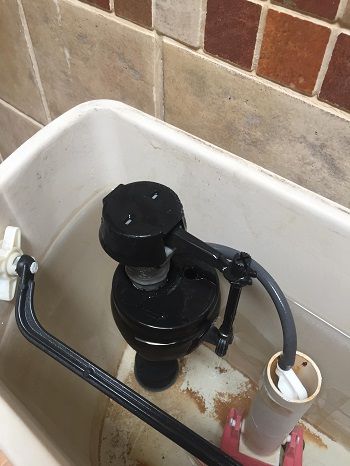
Once you have finished your business at the toilet you press the handle of the toilet tank which will release the water. The water will flow down with great force to the toilet bowl creating enough pressure to empty contents into the drain and subsequently down to the sewer.
The bowl has a bent tube at the rear which will prevent all the water from draining out of the toilet bowl. The water is kept there to seal the drain pipe and prevent bad smell from floating up from the sewer into your bathroom.
What Is The Toilet Valve And How Does It Function?
As we mentioned there is a tank that holds the water for you to flush down the contents of the bowl. How does the water fill the tank?
There is an inlet pipe that brings water to the tank. It is connected to the side of the tank. Inside the tank, there is the toilet valve which will control the flow of water into the tank. You don’t have to open and close the inlet pipe to regulate the flow of water into the tank.
It is done by the toilet valve. If the water is not controlled it can overflow from the tank and fall onto the floor of the bathroom. So, the toilet valve has an important function of ensuring that your tank is full and doesn’t overflow.
The toilet valve consists of the valve which is attached to the floor of the tank where the inlet pipe enters. There is a float that is attached to the valve by a steel rod. The float moves up and down with the level of the water opening or closing the valve. When the water is full, the float is fully raised and it shuts off the water into the tank completely. This is how the toilet valve prevents the tank from overflowing.
There are times when you may have to replace the toilet valve. There are natural wear and tear which will make the valve malfunction. This will result in the inflow of water not stopping and the water overflowing into the toilet bowl. There can be a lot of wastage of water. In the older models, the water can overflow on to the floor of the bathroom.
The First Step Is Removal Of The Existing Toilet Valve
Before you can fix the new valve, you must remove the existing valve. The first step to this is to stop the water supply to the flush tank. Once you stop the water supply you should drain the tank. Flush to remove water.
Then open the top lid and hold down the flush valve lever to completely drain the water to the toilet bowl. Even after this, there can be a small amount of water in the tank. You can use a sponge to absorb the balance of water.
The toilet valve is placed off to one side of the toilet and attached to the bottom. It consists of the valve and the float. In modern tanks, the valve and the float are attached and form a single assembly. In the older models, the float is separate but attached to the valve.
A tube will lead to the overflow pipe. You will find the connection of the inlet pipe to the fill valve underneath the tank. Unscrew by hand and remove the pipe. Keep a towel ready for some water that will drip from the valve.
Installing The New Toilet Valve To The Tank
Usually, all the valves fit all the tanks. It is always the same size. However, it is better to take the old valve when you go to buy a new one. Even if your existing fill valve is the old model you can buy a new model that comes with the float attached to it.
It will still fit the toilet tank. The new valve will come fully assembled. So, you should not have any problems fitting it straight to the tank. Read the instructions given on the new toilet valve so that you don’t make any mistakes while fitting it to the tank. You must remember to attach the new refill tube to the overflow pipe of the flush valve so that excess water can flow into the toilet bowl.
One of the most important things is to ensure that you have fixed all the washers when you install the new toilet valve. There are usually washers both inside the tank and outside it where the valve is attached to the inlet pipe.
The use of these washers is to ensure that there is no leakage of water where it is connected to the inlet pipe. The tank remains filled with water all the time and leaks are a possibility. Once you have installed the toilet valve you must now connect the inlet pipe and tighten the lock nut.
Conclusion
There are certain things you must take care when fixing the toilet valve. Once you have connected the inlet pipe, the lock nut must be screwed only by hand. Using a wrench can break the tank or the valve.
The nut must be tightened only enough to secure the inlet pipe. When you have installed the valve, you can turn on the water. When you turn on the water you must notice if there are any leaks. If you find any leaks you must shut the water supply and explore the reasons for the leak.
It is essential to position the float correctly to avoid the overflow of water. You can adjust the float using the adjustment screw on top of the valve. The top of the float must be around one inch above the overflow pipe so that no water will be wasted by overflowing into the toilet bowl.
Leave a Reply